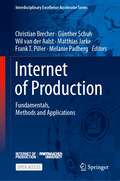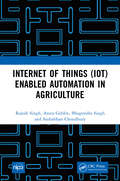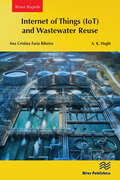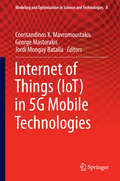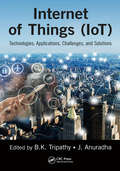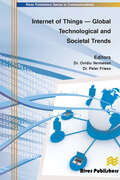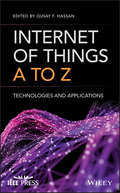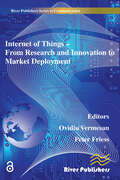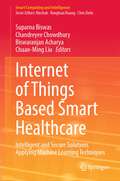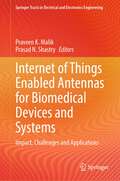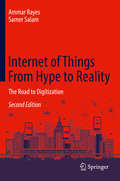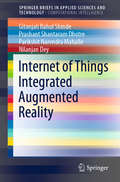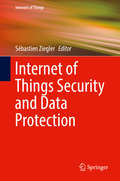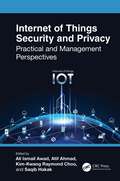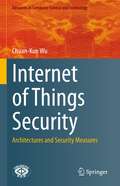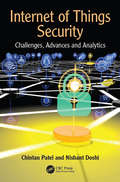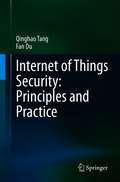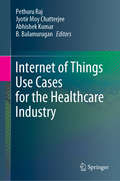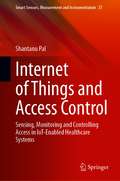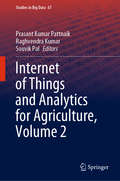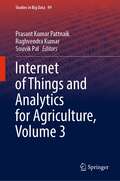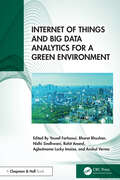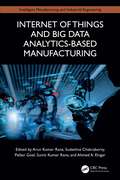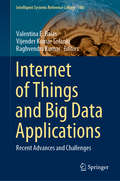- Table View
- List View
Internet of Production: Fundamentals, Methods and Applications (Interdisciplinary Excellence Accelerator Series)
by Matthias Jarke Christian Brecher Günther Schuh Frank T. Piller Wil van der Aalst Melanie PadbergThis seminal compendium, available through open access, illuminates the forefront of digital collaboration in production. It introduces the visionary concept of the Internet of Production (IoP), an ambitious initiative by Germany's esteemed Cluster of Excellence at RWTH Aachen University. This handbook pioneers the integration of data, models, and knowledge across development, production, and user cycles, offering interdisciplinary insights into production technology's horizons with the overall objective to create a worldwide lab.The work is organized into seven key parts, each contributing to a comprehensive understanding of the IoP. Part I lays the foundation with interdisciplinary visions and concepts. Part II delves into IoP's infrastructure, encompassing digital shadows and actionable artificial intelligence. Part III examines materials within the digitalized production landscape. Part IV confronts the challenges and potentials of production processes under novel digitalization methods.Part V focuses on production management with data-driven decision support, while Part VI explores agile development processes. Finally, Part VII delves into the interplay between internal and external perspectives in the IoP, human-centered work design, and platform-based ecosystems.Supported by the German Research Foundation (DFG), this compendium redefines manufacturing through the transformative IoP lens. Embrace this scholarly endeavor to embrace technological advancement. This is an open access book.
Internet of Things (IoT) Enabled Automation in Agriculture
by Rajesh Singh Sushabhan Choudhury Anita Gehlot Bhupendra SinghThis book provides basic knowledge of the programming and interfacing of devices with IoT modem and programming. The aim is to explain the basic steps to understand the IoT and its application in agriculture field. It will serve be a reference book for postgraduate and undergraduate Engineering students. Students from Electronics, Electrical, Mechatronics, Robotics, Mechanical, Computer science can use the book for their projects and research. This book is based entirely on the practical experience of the authors while undergoing projects with the students and industries. This book is co-published with NIPA. Taylor and Francis does not sell or distribute its print and electronic editions in India, Pakistan, Nepal, Bhutan, Bangladesh and Sri Lanka.
Internet of Things (IoT) and Wastewater Reuse
by A. K. Haghi Ana Cristina Faria RibeiroThis work aims to present the practical application of an IoT model that can be used as the solution to the problems of water facilities. It presents IoT as one of the efficient tools for the control of a set of water and wastewater networks. Another novelty of this work is to investigate the utilization of remote sensing (RS) facilities equipped with networked sensors, advanced modems, data loggers, and the IoT in a case study. This volume is ideal for water industry personnel, academic staff, and master/research students in environmental engineering science.
Internet of Things (IoT) in 5G Mobile Technologies
by Constandinos X. Mavromoustakis George Mastorakis Jordi Mongay BatallaThis book reports on the latest advances in the modeling, analysis and efficient management of information in Internet of Things (IoT) applications in the context of 5G access technologies. It presents cutting-edge applications made possible by the implementation of femtocell networks and millimeter wave communications solutions, examining them from the perspective of the universally and constantly connected IoT. Moreover, it describes novel architectural approaches to the IoT and presents the new framework possibilities offered by 5G mobile networks, including middleware requirements, node-centrality and the location of extensive functionalities at the edge. By providing researchers and professionals with a timely snapshot of emerging mobile communication systems, and highlighting the main pitfalls and potential solutions, the book fills an important gap in the literature and will foster the further developments of 5G hosting IoT devices.
Internet of Things (IoT): Technologies, Applications, Challenges and Solutions
by B. K. Tripathy J. AnuradhaThe term IoT, which was first proposed by Kevin Ashton, a British technologist, in 1999 has the potential to impact everything from new product opportunities to shop floor optimization to factory worker efficiency gains, that will power top-line and bottom-line gains. As IoT technology is being put to diversified use, the current technology needs to be improved to enhance privacy and built secure devices by adopting a security-focused approach, reducing the amount of data collected, increasing transparency and providing consumers with a choice to opt out. Therefore, the current volume has been compiled, in an effort to draw the various issues in IoT, challenges faced and existing solutions so far. Key Points: • Provides an overview of basic concepts and technologies of IoT with communication technologies ranging from 4G to 5G and its architecture. • Discusses recent security and privacy studies and social behavior of human beings over IoT. • Covers the issues related to sensors, business model, principles, paradigms, green IoT and solutions to handle relevant challenges. • Presents the readers with practical ideas of using IoT, how it deals with human dynamics, the ecosystem, the social objects and their relation. • Deals with the challenges involved in surpassing diversified architecture, protocol, communications, integrity and security.
Internet of Things - Global Technological and Societal Trends from Smart Environments and Spaces to Green Ict: Global Technological And Societal Trends From Smart Environments And Spaces To Green Ict (River Publishers Series In Communications Ser.)
by Mark Harrison Ramjee Prasad Hui Zhang Jing He Alessandro Bassi Long Cheng Latif Ladid Jian Ma Sébastien Ziegler Rob Van Kranenburg Vandana Rohokale Weili Han Ken Sakamura Ovidiu Vermesan Peter Friess Dr Ovidiu Vermesan Dr Peter Friess Patrick Guillemin Sergio Gusmeroli Harald Sundmaeker Ignacio Soler Jubert Margaretha Mazura Markus Eisenhauer Pat Doody Gérald Santucci Chiaki Ishikawa Lirong Zheng Xiaolin Zhou Zhi Zhang Yun Gu Junyu Wang José Roberto de Almeida Amazonas Sangjin Jeong Myung-Ki Shin Hyoung-Jun Kim Rajeev Prasad Neeli Prasad Marylin Arndt Philippe Cousin Patrick GrosseteteThe book's aim is to define the Internet of Things (IoT) in a global view, present the research agenda for Internet of Things technologies by addressing the new technological developments and providing a global balanced coverage of the challenges and the technical and industrial trends.Energy consumption by the data, communication and networking devices and global CO2 emission is increasing exponentially. ICT has a dual role in this process: it accounts for about two percent of global CO2 emissions and at the same the ICT including IoT technologies and applications have a direct effect on lowering CO2 emissions, increasing energy efficiency, reducing power consumption, and achieving efficient waste recycling.The book builds on the ideas put forward by the European research Cluster on the Internet of Things Strategic Research Agenda and presents global views and state of the art results on the challenges facing the research, development and deployment of IoT at the global level.IoT together with the other emerging Internet developments such as Internet of Energy, Media, People, Services, Business/Enterprises are the backbone of the digital economy, the digital society and the foundation for the future knowledge based economy and innovation society. IoT developments show that we will have 16 billion connected devices by the year 2020 , which will average out to six devices per person on earth and to many more per person in digital societies.Devices like smart phones and machine to machine or thing to thing communication will be the main drivers for further IoT development.
Internet of Things A to Z: Technologies and Applications
by Qusay F. HassanA comprehensive overview of the Internet of Things’ core concepts, technologies, and applications Internet of Things A to Z offers a holistic approach to the Internet of Things (IoT) model. The Internet of Things refers to uniquely identifiable objects and their virtual representations in an Internet-like structure. Recently, there has been a rapid growth in research on IoT communications and networks, that confirms the scalability and broad reach of the core concepts. With contributions from a panel of international experts, the text offers insight into the ideas, technologies, and applications of this subject. The authors discuss recent developments in the field and the most current and emerging trends in IoT. In addition, the text is filled with examples of innovative applications and real-world case studies. Internet of Things A to Z fills the need for an up-to-date volume on the topic. This important book: Covers in great detail the core concepts, enabling technologies, and implications of the Internet of Things Addresses the business, social, and legal aspects of the Internet of Things Explores the critical topic of security and privacy challenges for both individuals and organizations Includes a discussion of advanced topics such as the need for standards and interoperability Contains contributions from an international group of experts in academia, industry, and research Written for ICT researchers, industry professionals, and lifetime IT learners as well as academics and students, Internet of Things A to Z provides a much-needed and comprehensive resource to this burgeoning field.
Internet of Things Applications - From Research and Innovation to Market Deployment: From Research And Innovation To Market Deployment (River Publishers Series In Communications Ser.)
by Ovidiu Vermesan Peter FriessThe book aims to provide a broad overview of various topics of Internet of Things from the research, innovation and development priorities to enabling technologies, nanoelectronics, cyber physical systems, architecture, interoperability and industrial applications. It is intended to be a standalone book in a series that covers the Internet of Things activities of the IERC – Internet of Things European Research Cluster from technology to international cooperation and the global "state of play".The book builds on the ideas put forward by the European research Cluster on the Internet of Things Strategic Research Agenda and presents global views and state of the art results on the challenges facing the research, development and deployment of IoT at the global level. Internet of Things is creating a revolutionary new paradigm, with opportunities in every industry from Health Care, Pharmaceuticals, Food and Beverage, Agriculture, Computer, Electronics Telecommunications, Automotive, Aeronautics, Transportation Energy and Retail to apply the massive potential of the IoT to achieving real-world solutions. The beneficiaries will include as well semiconductor companies, device and product companies, infrastructure software companies, application software companies, consulting companies, telecommunication and cloud service providers. IoT will create new revenues annually for these stakeholders, and potentially create substantial market share shakeups due to increased technology competition. The IoT will fuel technology innovation by creating the means for machines to communicate many different types of information with one another while contributing in the increased value of information created by the number of interconnections among things and the transformation of the processed information into knowledge shared into the Internet of Everything. The success of IoT depends strongly on enabling technology development, market acceptance and standardization, which provides interoperability, compatibility, reliability, and effective operations on a global scale. The connected devices are part of ecosystems connecting people, processes, data, and things which are communicating in the cloud using the increased storage and computing power and pushing for standardization of communication and metadata. In this context security, privacy, safety, trust have to be address by the product manufacturers through the life cycle of their products from design to the support processes. The IoT developments address the whole IoT spectrum - from devices at the edge to cloud and datacentres on the backend and everything in between, through ecosystems are created by industry, research and application stakeholders that enable real-world use cases to accelerate the Internet of Things and establish open interoperability standards and common architectures for IoT solutions. Enabling technologies such as nanoelectronics, sensors/actuators, cyber-physical systems, intelligent device management, smart gateways, telematics, smart network infrastructure, cloud computing and software technologies will create new products, new services, new interfaces by creating smart environments and smart spaces with applications ranging from Smart Cities, smart transport, buildings, energy, grid, to smart health and life. Technical topics discussed in the book include: • Introduction• Internet of Things Strategic Research and Innovation Agenda• Internet of Things in the industrial context: Time for deployment.• Integration of heterogeneous smart objects, applications and services• Evolution from device to semantic and business interoperability• Software define and virtualization of network resources• Innovation through interoperability and standardisation when everything is connected anytime at anyplace• Dynamic context-aware scalable and trust-based IoT Security, Privacy framework• Federated Cloud service management and the Internet of Things• Internet of Things Applications
Internet of Things Based Smart Healthcare: Intelligent and Secure Solutions Applying Machine Learning Techniques (Smart Computing and Intelligence)
by Chuan-Ming Liu Biswaranjan Acharya Chandreyee Chowdhury Suparna BiswasThis book provides both the developers and the users with an awareness of the challenges and opportunities of advancements in healthcare paradigm with the application and availability of advanced hardware, software, tools, technique or algorithm development stemming the Internet of Things. The book helps readers to bridge the gap in their three understanding of three major domains and their interconnections: Hardware tested and software APP development for data collection, intelligent protocols for analysis and knowledge extraction. Medical expertise to interpret extracted knowledge towards disease prediction or diagnosis and support. Security experts to ensure data correctness for precise advice. The book provides state-of-the-art overviews by active researchers, technically elaborating healthcare architectures/frameworks, protocols, algorithms, methodologies followed by experimental results and evaluation. Future direction and scope will be precisely documented for interested readers.
Internet of Things Enabled Antennas for Biomedical Devices and Systems: Impact, Challenges and Applications (Springer Tracts in Electrical and Electronics Engineering)
by Prasad N. Shastry Praveen K. MalikThe book consists of the latest research in biomedical and communication integration. It discusses the fabrication and testing outcomes of the Internet of Things-enabled biomedical applications. The book focuses on recent advances in the field of planar antenna design and their applications in space communication, mobile communication, wireless communication, and wearable applications. Planar antennas are also used in medical applications in microwave imaging, medical implants, hyperthermia treatments, and wireless wellness monitoring. This book presents planar antenna design concepts, methods, and techniques to enhance the performance parameters and applications for IoT and device-to-device communication. It provides the latest techniques used for the design of antennas in terms of their structures, defected ground, MIMO, and fractal design. This book also addresses the specific steps to resolve issues in designing antennas and how to design conformal and miniaturized antenna structures for various applications.
Internet of Things From Hype to Reality: The Road to Digitization
by Ammar Rayes Samer SalamThis textbook presents an end-to-end Internet of Things (IoT) architecture that comprises of devices, network, compute, storage, platform, applications along with management and security components with focus on the missing functionality in the current state of the art. As with the first edition, it is organized into six main parts: an IoT reference model; Fog computing and the drivers; IoT management and applications ranging from smart homes to manufacturing and energy conservation solutions; Smart Services in IoT; IoT standards; and case studies. The textbook edition features a new chapter entitled The Blockchain in IoT, updates based on latest standards and technologies, and new slide ware for professors. It features a full suite of classroom material for easy adoption.
Internet of Things Integrated Augmented Reality (SpringerBriefs in Applied Sciences and Technology)
by Nilanjan Dey Gitanjali Rahul Shinde Prashant Shantaram Dhotre Parikshit Narendra MahalleThis book discusses the use of converged technology, a rapidly growing area that enhancements smart devices, communication, Internet of things (IoT), and augmented reality (AR). The book also explores the need for convergence of IoT and AR for various purposes, like personalized services, context awareness, and bridging the gap between the physical and digital world. Furthermore, it examines the implementation of IoT and AR in use cases to define pathways that allow application developers to design modern solutions to satisfy requirements like scalability, abstraction and security. Featuring an introduction, and covering sensing techniques, and effective architecture in AR-based IoT real-time use cases, the book also addresses the issues and challenges in designing standard architecture and middleware to support diverse applications. Given its scope, it is a valuable resource for teachers and students in engineering, as well as researchers, developers, and users working in multi-disciplinary areas.
Internet of Things Security and Data Protection (Internet of Things)
by Sébastien ZieglerThis book provides an overview of the most recent developments in Internet of Things (IoT) security and data protection. It presents the results of several international research projects addressing this topic from complementary angles. It starts by analyzing the main privacy and security threats on IoT, as well as the evolution of data protection norms, such as the European General Data Protection Regulation (GDPR), and their impact on IoT. Through a comprehensive and systematic approach, the contributors present new perspectives on IoT & Cloud Computing security requirements. They discuss the most recent approach to support trusted IoT, including new models of privacy risk assessment, labeling and certification, and contractual tools (such as Privacy PACT). Practical implementations, such as in the European Large Scale Pilots on IoT for Smart Cities (Synchronicity), are presented, explaining how they address security, privacy and data protection. Finally, innovative models to secure IoT systems are presented for the network and end-nodes security, including network threats analysis.
Internet of Things Security and Privacy: Practical and Management Perspectives
by Ali Ismail Awad Kim-Kwang Raymond Choo Saqib Hakak Atif AhmadThe Internet of Things (IoT) concept has emerged partly due to information and communication technology developments and societal needs, expanding the ability to connect numerous objects. The wide range of facilities enabled by IoT has generated a vast amount of data, making cybersecurity an imperative requirement for personal safety and for ensuring the sustainability of the IoT ecosystem. This book covers security and privacy research in the IoT domain, compiling technical and management approaches, addressing real-world problems, and providing practical advice to the industry. This book also includes a collection of research works covering key emerging trends in IoT security and privacy that span the entire IoT architecture layers, focusing on different critical IoT applications such as advanced metering infrastructure and smart grids, smart locks, and cyber-physical systems. The provided state-of-the-art body of knowledge is essential for researchers, practitioners, postgraduate students, and developers interested in the security and privacy of the IoT paradigm, IoT-based systems, and any related research discipline. This book is a valuable companion and comprehensive reference for postgraduate and senior undergraduate students taking an advanced IoT security and privacy course.
Internet of Things Security: Architectures and Security Measures (Advances in Computer Science and Technology)
by Chuan-Kun WuThis book presents a systematic and comprehensive overview for IoT security. It first introduces architecture approaches for IoT and IoT security, describing the security techniques for different layers in the IoT security architecture. It also provides an in-depth analysis on the difference between IoT security and traditional system and data security. It is commonly known that information security includes data confidentiality, data integrity, and availability, and that measures include non-repudiation and access control. However, in practical IoT system construction, many more security measures need to be carefully considered. As such, this book presents around 60 different security measures, mainly focusing on the sensor layer of IoT. These security measures can serve as a source of reference for IoT system construction, as well as IoT security standard making.
Internet of Things Security: Challenges, Advances, and Analytics
by Chintan Patel Nishant DoshiMost of the devices in the Internet of Things will be battery powered sensor devices. All the operations done on battery powered devices require minimum computation. Secure algorithms like RSA become useless in the Internet of Things environment. Elliptic curve based cryptography emerges as a best solution for this problem because it provides higher security in smaller key size compare to RSA. This book focuses on the use of Elliptic Curve Cryptography with different authentication architectures and authentication schemes using various security algorithms. It also includes a review of the math required for security and understanding Elliptic Curve Cryptography.
Internet of Things Security: Principles and Practice
by Qinghao Tang Fan DuOver the past few years, Internet of Things has brought great changes to the world. Reports show that, the number of IoT devices is expected to reach 10 billion units within the next three years. The number will continue to rise and wildly use as infrastructure and housewares with each passing day, Therefore, ensuring the safe and stable operation of IoT devices has become more important for IoT manufacturers. Generally, four key aspects are involved in security risks when users use typical IoT products such as routers, smart speakers, and in-car entertainment systems, which are cloud, terminal, mobile device applications, and communication data. Security issues concerning any of the four may lead to the leakage of user sensitive data. Another problem is that most IoT devices are upgraded less frequently, which leads it is difficult to resolve legacy security risks in short term. In order to cope with such complex security risks,Security Companies in China, such as Qihoo 360, Xiaomi, Alibaba and Tencent, and companies in United States, e.g. Amazon, Google, Microsoft and some other companies have invested in security teams to conduct research and analyses, the findings they shared let the public become more aware of IoT device security-related risks. Currently, many IoT product suppliers have begun hiring equipment evaluation services and purchasing security protection products. As a direct participant in the IoT ecological security research project, I would like to introduce the book to anyone who is a beginner that is willing to start the IoT journey, practitioners in the IoT ecosystem, and practitioners in the security industry. This book provides beginners with key theories and methods for IoT device penetration testing; explains various tools and techniques for hardware, firmware and wireless protocol analysis; and explains how to design a secure IoT device system, while providing relevant code details.
Internet of Things Use Cases for the Healthcare Industry
by Pethuru Raj Abhishek Kumar Jyotir Moy Chatterjee B. BalamuruganThis book explores potentially disruptive and transformative healthcare-specific use cases made possible by the latest developments in Internet of Things (IoT) technology and Cyber-Physical Systems (CPS). Healthcare data can be subjected to a range of different investigations in order to extract highly useful and usable intelligence for the automation of traditionally manual tasks. In addition, next-generation healthcare applications can be enhanced by integrating the latest knowledge discovery and dissemination tools. These sophisticated, smart healthcare applications are possible thanks to a growing ecosystem of healthcare sensors and actuators, new ad hoc and application-specific sensor and actuator networks, and advances in data capture, processing, storage, and mining. Such applications also take advantage of state-of-the-art machine and deep learning algorithms, major strides in artificial and ambient intelligence, and rapid improvements in the stability and maturity of mobile, social, and edge computing models.
Internet of Things and Access Control: Sensing, Monitoring and Controlling Access in IoT-Enabled Healthcare Systems (Smart Sensors, Measurement and Instrumentation #37)
by Shantanu PalThis book presents the design and development of an access control architecture for the Internet of Things (IoT) systems. It considers the significant authentication and authorization issues for large-scale IoT systems, in particular, the need for access control, identity management, delegation of access rights and the provision of trust within such systems. It introduces a policy-based access control approach for the IoT that provides fine-grained access for authorized users to services while protecting valuable resources from unauthorized access. Further, the book discusses an identity-less, asynchronous and decentralized delegation model for the IoT leveraging the advantage of blockchain technology. It also presents an approach of attribute-based identity and examines the notion of trust in an IoT context by considering the uncertainty that exists in such systems. Fully explaining all the techniques used, the book is of interest to engineers, researchers and scientists working in the field of the wireless sensor networks, IoT systems and their access control management.
Internet of Things and Analytics for Agriculture, Volume 2 (Studies in Big Data #67)
by Prasant Kumar Pattnaik Raghvendra Kumar Souvik PalThis book addresses major challenges faced by farmers and the technological solutions based on Internet of Things (IoT). A major challenge in agriculture is cultivating and supplying high-quality produce at the best. Currently, around 50% of global farm produce never reaches the end consumer due to wastage and suboptimal prices. The book presents solutions that reduce the transport costs, improve the predictability of prices based on data analytics and the current market conditions, and reduce the number of middle steps and agents between the farmer and the end consumer. It discusses the design of an IoT-based monitoring system to analyze crop environments and a method to improve the efficiency of decision-making by analyzing harvest statistics. Further, it explores climate-smart methods, known as smart agriculture, that have been adopted by a number of Indian farmers.
Internet of Things and Analytics for Agriculture, Volume 3 (Studies in Big Data #99)
by Prasant Kumar Pattnaik Raghvendra Kumar Souvik PalThe book discusses one of the major challenges in agriculture which is delivery of cultivate produce to the end consumers with best possible price and quality. Currently all over the world, it is found that around 50% of the farm produce never reaches the end consumer due to wastage and suboptimal prices. The authors present solutions to reduce the transport cost, predictability of prices on the past data analytics and the current market conditions, and number of middle hops and agents between the farmer and the end consumer using IoT-based solutions. Again, the demand by consumption of agricultural products could be predicted quantitatively; however, the variation of harvest and production by the change of farm's cultivated area, weather change, disease and insect damage, etc., could be difficult to be predicted, so that the supply and demand of agricultural products has not been controlled properly. To overcome, this edited book designed the IoT-based monitoring system to analyze crop environment and the method to improve the efficiency of decision making by analyzing harvest statistics. The book is also useful for academicians working in the areas of climate changes.
Internet of Things and BDS Application
by Bo Wang Xiangsheng Liu Yaqi ZhangThe book focuses on the Internet of Things and Beidou system application. Both principles and engineering practice have been addressed, with more weight placed on engineering practice. This is achieved by providing in-depth studies on a number of major topics of Beidou system application with the Internet of Things. Such comprehensive and systematic analysis is particularly suited for readers who are interested to learn practical solutions in Beidou system application. The book can benefit researchers, engineers, and graduate students in the fields of positioning and navigation, geospatial engineering, telecommunications, etc.
Internet of Things and Big Data Analytics for a Green Environment
by Bharat Bhushan Anshul Verma Yousef Farhaoui Agbotiname Lucky Imoize Nidhi Sindhwani Rohit AnandThis book studies the evolution of sustainable green smart cities and demonstrates solutions for green environmental issues using modern industrial IoT solutions. It is a ready reference with guidelines and a conceptual framework for context-aware product development and research in the IoT paradigm and Big Data Analytics for a Green Environment. It brings together the most recent advances in IoT and Big Data in Green Environments, emerging aspects of the IoT and Big Data for Green Cities, explores key technologies, and develops new applications in this research field.Key Features:• Discusses the framework for development and research in the IoT Paradigm and Big Data Analytics.• Highlights threats to the IoT architecture and Big Data Analytics for a Green Environment. • Present the I-IoT architecture, I-IoT applications, and their characteristics for a Green Environment. • Provides a systematic overview of the state-of-the-art research efforts.• Introduces necessary components and knowledge to become a vital part of the IoT revolution for a Green Environment.This book is for professionals and researchers interested in the emerging technology of sustainable development, green cities, and Green Environment.
Internet of Things and Big Data Analytics-Based Manufacturing (Intelligent Manufacturing and Industrial Engineering)
by Ahmed A. Elngar Arun Kumar Rana Sudeshna Chakraborty Pallavi Goel Sumit Kumar RanaBy enabling the conversion of traditional manufacturing systems into contemporary digitalized ones, Internet of Things (IoT) adoption in manufacturing creates huge economic prospects through reshaping industries. Modern businesses can more readily implement new data-driven strategies and deal with the pressure of international competition thanks to Industrial IoT. But as the use of IoT grows, the amount of created data rises, turning industrial data into Industrial Big Data.Internet of Things and Big Data Analytics-Based Manufacturing shows how Industrial Big Data can be produced as a result of IoT usage in manufacturing, considering sensing systems and mobile devices. Different IoT applications that have been developed are demonstrated and it is shown how genuine industrial data can be produced, leading to Industrial Big Data. This book is organized into four sections discussing IoT and technology, the future of Big Data, algorithms, and case studies demonstrating the use of IoT and Big Data in a variety of industries, including automation, industrial manufacturing, and healthcare.This reference title brings all related technologies into a single source so that researchers, undergraduate and postgraduate students, academicians, and those in the industry can easily understand the topic and further their knowledge.
Internet of Things and Big Data Applications: Recent Advances and Challenges (Intelligent Systems Reference Library #180)
by Raghvendra Kumar Valentina E. Balas Vijender Kumar SolankiThis book provides essential future directions for IoT and Big Data research. Thanks to rapid advances in sensors and wireless technology, Internet of Things (IoT)-related applications are attracting more and more attention. As more devices are connected, they become potential components for smart applications. Thus, there is a new global interest in these applications in various domains such as health, agriculture, energy, security and retail. The main objective of this book is to reflect the multifaceted nature of IoT and Big Data in a single source. Accordingly, each chapter addresses a specific domain that is now being significantly impacted by the spread of soft computing
